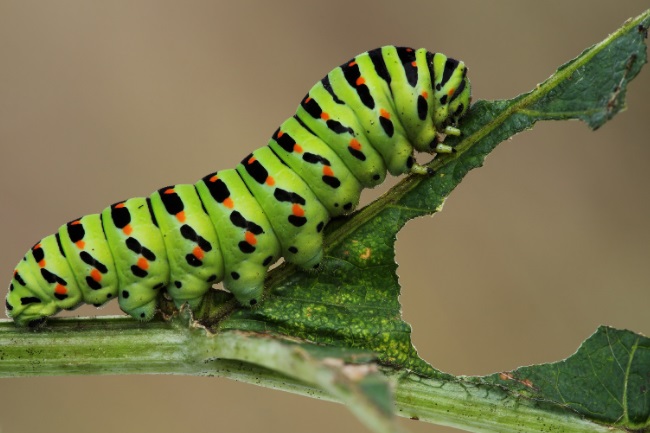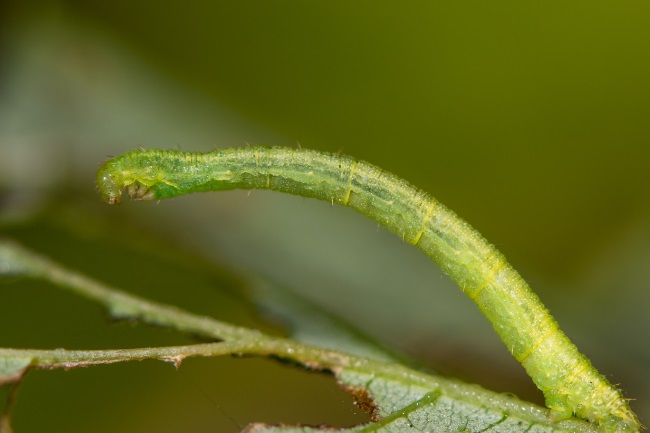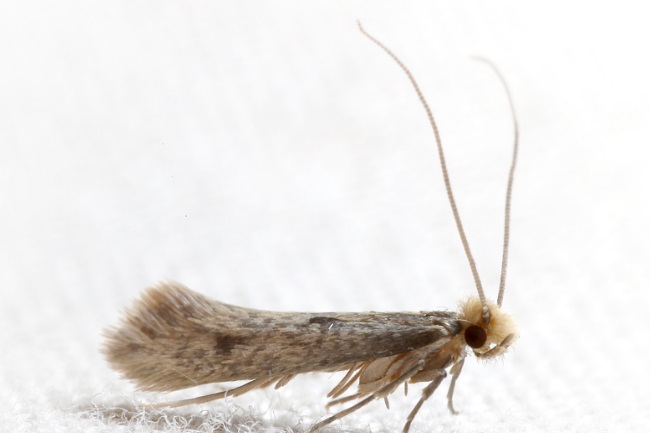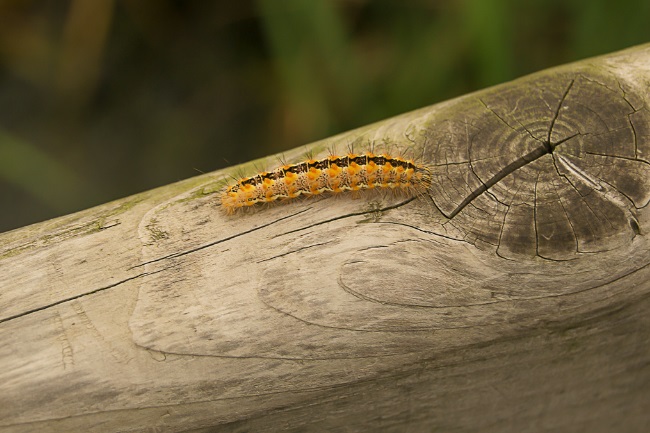Caterpillars eat a vast range of things. Whilst most eat plant matter, some are meat-eaters. Some eat particular strange things such as hair or dead mice.
Contents
What is a caterpillar?

Caterpillars are the larval stage of insects within the Lepidoptera group; this means moth and butterfly species. All caterpillars start as an egg and then moult their exoskeletons as they grow in size. Once the caterpillar has eaten enough, it will become a pupa, or chrysalis, from which it will emerge as an adult butterfly or moth. Many other insects go through similar life stages, such as the grubs of beetles or the larvae of ants; however, caterpillars are arguably the best known and loved larvae of any species.
Also read: Is a Caterpillar an Insect? (Explained)
How does a caterpillar eat?
Caterpillars generally clasp their food with their front legs and use their sharp jaws, known as mandibles, to tear off chunks. The food is then further broken down by the small jaw parts behind, known as the maxilla.
Caterpillars can taste and smell using the maxilla and tiny antennae located above their mouths. These are vital senses for this insect as many of the food they eat, such as plant matter, can contain deadly toxins, which they need to avoid.

The rest of the caterpillar’s digestive tract is largely a big tube, made up of a fore and hindgut. Food moves through this system to be excreted out the other end. Like most insects, caterpillars do not urinate, instead producing frass, which is a mixture of uric acid and faeces. This system helps them preserve water.
Some caterpillars also produce a type of honeydew. This is a sweet secretion that helps get rid of excess sugars they accumulate from eating plant sap.
Who can talk about a caterpillar’s diet without mentioning the favourite children’s book ‘The Very Hungry Caterpillar’. Perhaps thinking that a caterpillar would like to munch down a piece of cake or a pizza is a little ambitious. Still, across the over 130,000 species that exist across the world, there’s a wide range of diets, from herbivores to carnivores.
Also read: What Caterpillar Eats Parsley? (List of Species)
Vegan caterpillars
Quite rightly, when we think of caterpillars, we mostly think of herbivorous species. This is because the majority of caterpillars do eat a vegan diet. Cabbage whites in Europe are particularly disliked for their preference for all brassica species. As anyone who has tried to grow a nice broccoli or kale plant will know, these hungry caterpillars can quickly munch away all you love. The small pale green caterpillars are well camouflaged to their habitat and often feed on undersides of plant leaves, remaining hidden from predators.
| Caterpillar Species | Diet |
|---|---|
| Monarch Caterpillar | Feeds primarily on milkweed plants (Asclepias spp.). |
| Swallowtail Caterpillar | Consumes leaves of various host plants, such as dill, parsley, fennel, or citrus trees. |
| Cabbage White Caterpillar | Feeds on cabbage family plants, including cabbage, broccoli, kale, and mustard greens. |
| Tent Caterpillar | Eats the leaves of a wide range of deciduous trees, such as apple, cherry, and oak. |
| Gypsy Moth Caterpillar | Feeds on the foliage of various trees, including oak, birch, and aspen. |
Most caterpillars are very well adapted to feed on specific plants. This is in part because different plants have different methods to put off insects from eating them. By evolving alongside a particular plant, they can develop strategies to cope with the toxins they produce. A fascinating example of this is the cinnabar caterpillar. This brightly coloured caterpillar carries vibrant orange and black stripes, warning predators of the poisons they carry.
However, these little insects have stolen their toxins from the plants that they feed on, a yellow, daisy-like flower known as ragwort. This poison stays with these insects as they turn into dayflying moths, dressed in an attractive red and black. The mating ritual of these insects even involves the male passing the female a bundle of poisons for her to consume and pass on to her young.

Caterpillars don’t just focus on low growing vegetation. Many species are specialised to feed on particular tree species. In the US, the yellownecked caterpillar is considered an agricultural pest, as they can defoliate valuable fruit trees. The bird-cherry ermine caterpillar, found throughout Europe, is particularly dramatic, as it feeds within a silken web that it weaves around it with its siblings. These webs can sometimes cover the whole tree, and rows on effected trees can be wrapped up in silk, like something out of a haunted house.
When we talk about planting for pollinators, we tend to think of planting big beautiful flowers to help our butterflies and bees. However, many species of moths and butterflies rely heavily on grasses. The common grass Yorkshire fog, for example, is a foodplant for at least four species of butterfly.
Moss, too might not be something we associate with hungry insects, but many species of moth will happily spend their time eating this seemingly unappealing food. The common footman caterpillar is one of those that enjoy a nice chunk of moss. Some caterpillars even enjoy lichen, such as the brussel lace moth, which is beautifully camouflaged in the colours of its food. Though many caterpillars focus on the leaves of plants, some also eat the flowers. The star-wort caterpillar, for example, enjoys the purple daisy-like flowers of the sea aster.
Not many caterpillars have what it takes to eat the more challenging parts of a plant, but the beautiful lunar hornet moth does just this. Feast on the wood of sallows for two years, it emerges into an adult form that mimics the colours and forms of a hornet. It’s incredibly convincing but completely harmless.
From grasses to flowers to trees, it’s hard to find a plant that doesn’t have a caterpillar that will feast on it if it has the chance.
Also read: Are Caterpillars Poisonous? Are they Dangerous? (Explained)
Carnivore caterpillars

Eupithecia orichloris is a rather dull-looking moth that lives on the Hawaiin islands. Yet, in its larval stage, it does something quite extraordinary. Looking very much like many other small green caterpillars, this species holds onto a piece of vegetation and camouflages itself as a twig. Once something tasty comes along, it grabs hold of it with its front feet and gets straight to eating its helpless prey. Amazingly it’s not the only carnivorous caterpillar in Hawaii, with at least another seven species having taken the same path. These vicious killers will happily eat flies, spiders and even snails.
| Caterpillar Species | Diet |
|---|---|
| Assassin Caterpillar | Preys on other insects, such as aphids or small caterpillars. |
| Harvester Caterpillar | Feeds on woolly aphids, consuming their sugary secretions. |
| Wasp Moth Caterpillar | Hunts and consumes other insects, including ants and bees. |
| Tiger Swallowtail Caterpillar | Occasionally consumes small insects in addition to plant leaves. |
| Hornworm Caterpillar | Known for eating the leaves of tomato, tobacco, and other nightshade plants. |
These killer caterpillars are what is know as inchworm or looper caterpillars. This group has a set of legs at the back of their body, designed for clinging onto vegetation, and another at the front. They move by stretching out their bodies and gripping on with their forward legs, then lifting and moving their back legs forward, creating a loop. In our Hawaiin meat-eating caterpillars, these front legs have become sharp and pointed, acting together as a grabbing claw. They also have spines on their bodies that serve as a trigger for their attack, tripped when a hapless insect wanders past.
Less gruesome, but more disgusting perhaps, several caterpillars also live on animal waste. The skin moth will eat anything from animal droppings, owl pellets and dead bodies. Doesn’t sound particularly appealing.
Also read: Does a Caterpillar Have Legs? (Prolegs vs. True Legs)
Keratin eating caterpillars
More unusual than species that eat the soft, easily consumed parts of insects, are those that choose to feed exclusively on keratin. Keratin is what our fingernails are made of, as well as the horns of rhinos. Some caterpillars feed on the keratin bodyparts of dead animals, such as the hooves and horns. The moth Ceratophaga vicinella is even more specific, feeding only on the shells of dead gopher tortoises.

Perhaps the most famous of keratine eating caterpillars are the clothes moths. These caterpillars feed on natural fibres we use in our clothing, such as wool, silk and feathers. In nature, they would mostly feed on dead animals, but today our closets are a smorgasbord. Some clothes moths weave themselves little cases, which they drag around with them as camouflage.
Plastic eating caterpillars
The wax moth caterpillar, Galleria mellonella, spends its early life as a parasite with beehives, chomping down on the tasty wax that makes up the combs. The two known species of wax moths are considered a pest to commercial beekeepers, as they tunnel through the wax, causing the honey to leak away. Although they don’t eat the larvae, the young bees can become trapped in the silk the caterpillars fill their tunnels with.
Recently scientists have discovered that wax moths are able to eat plastic. Experiments involved feeding them plastic bags, which they ate slowly. Many people think this could be an innovative way to recycle our human waste.
Also read: What do Bumblebees Eat and Drink? (Habits Explained)
Ant loving caterpillars
Beyond the killer caterpillars of Hawaii, there are other meat-eating caterpillars. One particularly fascinating evolution in some species of caterpillar has been to take advantage of ant species. There are a surprising array of ways that caterpillars have learnt to do this, but the key ingredient is the use of a chemical disguise. Ants use chemical signals to communicate with each other, and the caterpillars have learnt to hijack this signal, persuading the ants they are one of them.
Many of us have heard of ant species ‘farming’ aphids and other sap-sucking insects. They do this by protecting the aphids from preditors, and in return, drink the sweet honeydew that they produce as a byproduct. Normally a caterpillar wouldn’t stand much of a chance against an army of ant guards. Still, the American Harvester caterpillar fools the ants into thinking it is one of them through the chemicals it emits.
Then it just wanders along the herd of woolly aphids chomping as it goes. Amazingly the woolly aphids make no attempt to go away. Perhaps the ant-like scent of this caterpillar leaves them to believe it will protect rather than harm them.

The European Alcon blue butterflies have developed an even smarter trick. Their caterpillars fool the ants into thinking they are one of their own larvae. On finding the caterpillar while out on a foraging trip, the ants collect it and take it back to their nest, where they feed it like one of their own. Unfortunately for the ants, the caterpillar will also feast on their young and eat them literally out of house and home. The butterfly will even pupate within the nest, safe from predators, and emerge as an adult.
However, not all ant relationships with caterpillars are negative. Many caterpillar species have special glades, which produce a honeydew-like substance. Now the wolf becomes the sheep, herded by the ants just as they herd aphids. In Australia, Bathurst copper butterflies get herded by the ants up to foliage to feed in the night and down into their nest for protection in the day.
But once again, caterpillars can be fiendishly deceitful. Acacia trees have developed fascinating relationships with ants. They often provide bed and breakfast, growing special hollow nodules for the ants to live in and producing a nectar-like substance that the ants can eat. By doing this, the acacia has its own army of bodyguards, which attack pest insects that come to feast on its leaves.
Yet, the caterpillar has learnt to smell and sound like the ant protectors. Not only this, but it uses its glands to bribe them with tasty treats. Now it can happily munch its way around the acacia undisturbed, with an entourage of ants to protect it from predators. Bad luck for the acacia.
Also read: Wondering “How Many Ants are in a Colony?” (FAQ)
Cannibal caterpillars
Though we may not like to think about it, many animal species will turn cannibal when the chips are down. For example, many rodents will eat their young when stressed, whilst some amphibians will eat their siblings if their pool starts to dry up before they are ready to leave.
Caterpillars, too, can turn nasty, and research has recently found this may be in part the doing of the plants they are feasting on. We don’t think of plants as communicating, but many release chemicals to tell their neighbours how things are going. In particular, if they are under attack, they will tell their friends to heighten their defences, pumping toxins into their leaves to make them inedible.
The armyworm caterpillars, found in the US, will turn on each other when their food source becomes too contaminated to eat. It’s truly survival of the fittest, with the bigger caterpillars generally consuming the smallest.
Also read: What Eats Caterpillars? (A List of its Enemies)
So what does a caterpillar eat?
Well, the answer is almost anything from plants to other insects to unexpected things like tortoiseshell. Very few caterpillars are true omnivores. Some caterpillars that parasitise ants, such as the Adonis blue, will spend their early days eating plant matter before turning to the ants for a meat feast. Most, however, are vegan.
Even more fascinating is that the adult forms, the butterflies and moths, have a completely different diet. So maybe the story of the very hungry caterpillar isn’t so far fetched after all.

